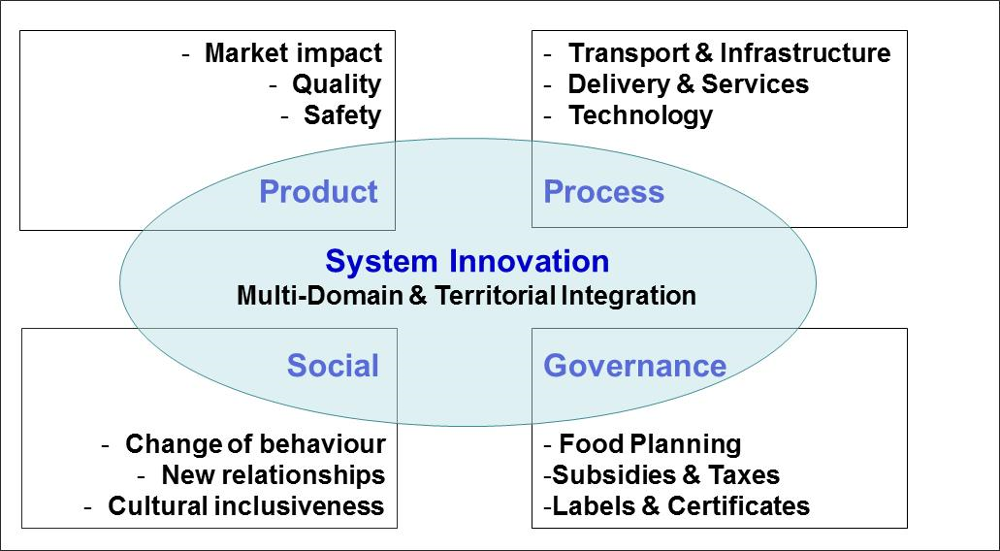Innovation in Short Food Supply Chain
Generally in the agro-food system, technological innovation is still considered the main driver for creating a competitive business advantage, rather than focussing on forms of social, economic and environmental innovation. Building on the work by Avermaete et al. (2003) we see added value in incorporating these innovation domains in an integrated research approach which we call system innovation (see Fig. 1). Drawing on Van der Vorst and Beulens (2002), FOODMETRES uses a list of redesign strategies for attaining more sustainable supply chain objectives and addressing the various system dimensions of food chains from a business perspective. Innovation storylines focus on innovation domain(s) and redesign principles that are relevant to regional stakeholders (mainly entrepreneurs) for developing more sustainable food chains. Beyond product innovations, these may emphasise process innovation such as the use of alternative energy sources or different forms of logistical arrangements. They could also target social innovation by involving the consumers at an early stage of the food chain – e.g., during the harvesting of food, or in governance innovation integrating new stakeholders into local food planning strategies. The storylines follow a pre-designed script, to allow for comparison across different commodities on a set of agreed-upon indicators. Scenarios are used to describe possible innovations and development pathways.
When dealing with practical examples of regional food supply in metropolitan regions it is useful to address the length of chains and use the criteria of the spatial and social proximity (see also Galli & Brunori 2013). Therefore, we characterize the regional chains according their length regarding the number of involved actors into:
- Long Regional Food Chains (occurring in MAS): means regional purchasing of food, where the food is regionally grown, processed, sold and consumed within a certain territorial unit=region (no matter how the region is defined). In comparison to global food chains the total transport distance is shortened (as physical and time distance). Long regional chains include a number of intermediaries/chain steps like wholesale and retail etc. within this region. Long regional chains are connected with the spatial concept of the Metropolitan Agri-food System (MAS).
- Short Regional Food Chains (occurring in LAS): means local purchasing of food, where the food is regionally grown, (processed), sold and consumed within a certain territorial unit=region (no matter how the region is defined). By reducing the number of intermediaries, SFC allows a closer/personal interaction between producer and consumer (social proximity). Short regional food chains are connected with the spatial concept of Local Agri-food System (LAS). They are comparable with concepts like “alternative food chains” and “local” food (systems)
- Long Global Food Chains (occurring in GAS): Today’s food consumption relies to a large degree on food imports from remote locations. This is the case for products such as exotic fruits, coffee, tea and chocolate, spices, marine animals as well as region-specific goods such as wines, olive oils or cheeses. Beside these import goods for direct consumption, meat consumption is largely based on the import of feedstuff such as soya, which is entering Europe via the Rotterdam harbour. Being part of our daily diet, Global Agro-Food Systems (GAS) products will continue to play a role and given their substantial impacts on the ecological footprint require special attention.
FOODMETRES has taken the Committee of the Regions (2011) as a starting point for categorizing food chains because it focuses on the market-relation and allows the integration of the new emerging phenomenon of Urban Gardening etc., where consumers become (co-)producers. We differentiate between four main categories of market relation between consumer and producer as well as related commercial transactions schemes:
- Consumers as producers (transaction scheme: not existing)
- Producer-consumer partnerships (transaction scheme: business-to-consumer)
- Producer direct sales to consumer (transaction scheme: business-to-consumer)
- Producer direct sales to intermediates / no direct consumer-producer relation (transaction scheme: business-to-business and business to administration).
These four main categories for chain types have been further broken down on the basis of chain length, the kind of intermediate chain actors (retail, hospitality industry, public procurement) and the location of the point of sale LAS/MAS/GAS affinity. Finally, we differentiated between six main types of regional and short food chains and related subtypes and venues. The place of production can be urban, peri-urban or rural. As for the place of consumption, we considered only the urban area. Each of them has been checked, if they exist within the six case study regions and if they were part of more detailed case studies. Locally, however, depending on the impact and policy area of interest, it would be necessary to apply specific and different SFSC types. In this respect, the developed SFSC typology also serves as a good communication tool. It can be expected that, in the future, the typology will be extended to cover further types and aspects of food chains not present in the FOODMETRES project.

